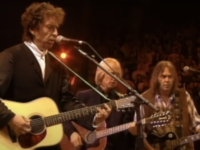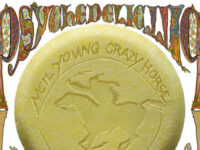Neil Young and Crazy Horse’s Greendale arrived on August 19, 2003, long after we thought the concept-album idea was dead. After all, we want instant gratification. We’ve got shrinking attention spans. Heck, back then, we couldn’t even make it all the way through an MTV video – just the “good parts” on TRL.
While Young’s not a part of that generation, it wouldn’t be unfair to say that he’s had his own issues with attention span. Which Neil Young do we get this time around? That’s always the question. The blistering rocker? The introspective folkie? Rockabilly Neil? Blues Neil? Techno synthy Neil? (OK, that might be going a little too far: Nobody is expecting Trans II anytime soon.)
It’s not that any of this is a bad thing. For a guy who’s been at it as long as Neil Young, the occasional fresh perspective can only be healthy.
And so we had Greendale, named after Young’s mythical coastal California town of 20-25,000 residents. All of the stories revolved around the Green family. There was mom and dad (Edith and Earl) who live at the Double E Rancho (just outside of Greendale), the young daughter (Sun), cousin Jed, and grandma and grandpa Green. More or less “normal” so far, right?
But then we find out that Sun’s grandmother (Ciela) had daughters by two different Green brothers (fade in appropriate David Lynch-type music here). It doesn’t get any more “normal” after that. There was murder. Art. The Devil. Death. Protest.
These themes are completed on Greendale with the return of Crazy Horse slow-rocker Neil, with touches of the introspective folkie. (Despite the delivery, it’s pretty obvious that folkie-Neil wrote these tunes.) The music is very straight-ahead Crazy Horse garage rock – but, curiously, without Frank Sampedro’s second guitar.
A repetition of musical themes (my favorite is the John Lee Hooker-like “Devil’s Sidewalk”) makes for a sorta hypnotic listening experience. Everything is slowed down and drawn out as Neil Young lays out his tales of the Greens. The only musical appearance of Neil the folkie is for the beautiful “Bandit.” Finally, the liner notes and artwork brought everything together nicely.
[SOMETHING ELSE! INTERVIEW: Nils Lofgren talks about collaborating with Neil Young – as well as key moments from his subsequent stint in the E Street Band, including the devastating loss of Clarence Clemons.]
Instead of lyrics there were, for each song, short stories that set up the weirdness to follow. Kliban-esque illustrations (hats off to James Mazzeo) complete the oddness that is Greendale. Not so odd, but still very entertaining, was the bonus DVD, Live at St. Vicar St., that has Neil performing Greendale in its entirety on acoustic guitar. In this format, the songs lost their sinister quality to become somehow more intimate – despite the subject matter.
You’ve gotta hand it to Neil Young. It seems like he’s been around forever (check out the book Shakey to find out just how much he’s been through) but he still managed to come up with something new after all those years, albums and tours.
- Why the Rolling Stones’ Harrowing ‘Gimme Shelter’ is Still Revealing New Depths - November 18, 2024
- How Talking Heads’ ‘Fear of Music’ Opened Up a World of Art and Sound - August 5, 2024
- How Deep Cuts Propelled Bruce Springsteen’s ‘Born in the U.S.A.’ - June 4, 2024



